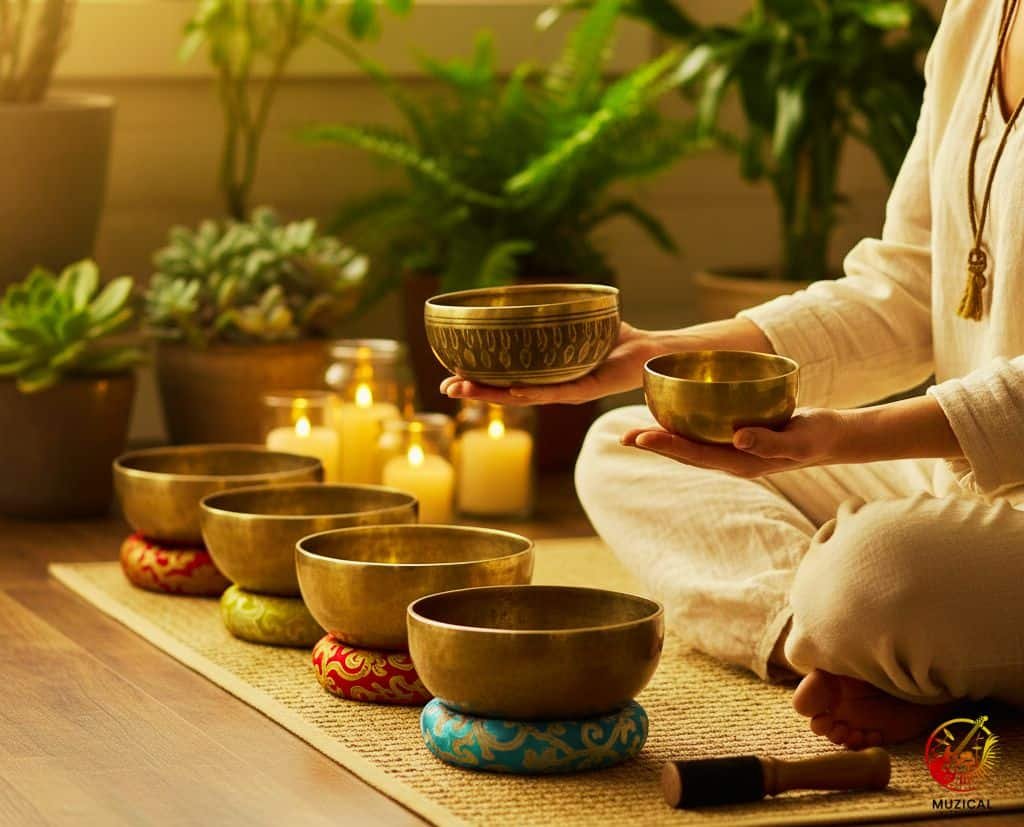Best Size Tibetan Singing Bowl for Beginners Meditation
The best size Tibetan singing bowl for beginners meditation is often between 6 to 8 inches in diameter. This range provides a balance of rich sound, comfortable handling, and affordability, which is why many teachers recommend it to newcomers.
If you start too small, the tone may feel thin and lack resonance. Go too big, and you may struggle with weight, storage, or cost.
Choosing the wrong size can make your practice harder, not easier. Meditation requires focus, and a bowl that feels awkward or overwhelming can break that flow. A well chosen beginner bowl helps you connect with sound more naturally.
In this guide, you’ll explore what size works best for first time users, how bowl size changes sound, practical tips for use, and expert insights. You’ll also see comparisons, cost factors, and step by step ways to start your sound journey.
How does the size of a Tibetan singing bowl affect meditation?

The size of a Tibetan singing bowl shapes its pitch, volume, and vibration. Larger bowls, often 10 inches or more, produce deeper tones that resonate through the body.
Smaller bowls, under 6 inches, create higher pitched sounds that are clear but short lived. Mid size bowls, between 6 to 8 inches, give you the best of both worlds: they are easy to use, affordable, and create tones that linger without being too heavy or sharp.
When you meditate, your brain and body respond to vibration. Deep sounds can feel grounding, almost like your body is being wrapped in calm energy. High tones, on the other hand, sharpen focus but may feel piercing if held too close. That’s why most beginners prefer mid sized bowls, they offer warmth without overwhelming.
Think of it like choosing a chair. A giant chair may feel cozy but is hard to move. A tiny stool works in a pinch but isn’t very comfortable for long sessions. A medium chair feels right for daily use. The same applies to singing bowls.
Pro Tip: Place the bowl on a soft cushion to let it vibrate freely. Pressing it down too hard on your hand or surface can mute the sound, no matter the size.
What is the best size Tibetan singing bowl for beginners meditation?

For most beginners, a bowl between 6 and 8 inches is the sweet spot. This size produces clear tones with a gentle echo, making it perfect for home meditation. It is big enough to create resonance yet small enough to handle without strain.
If you’re brand new, a 6 inch bowl may be easier to hold while practicing. You can place it in your palm or on a cushion and learn to play with the mallet. If you want more depth in your sound, move closer to 7 or 8 inches. Anything larger may feel awkward until you gain confidence.
Some teachers compare it to learning music. You don’t start with a concert grand piano; you begin with an instrument you can manage. Over time, as your ear grows, you might explore larger bowls for deeper tones.
Here’s a simple comparison:
| Bowl Size | Sound Quality | Ease of Use | Best For |
|---|---|---|---|
| 4–5 in | High pitch, short sustain | Very light | Travel, quick focus |
| 6–8 in | Balanced tone, good sustain | Easy | Beginners, daily meditation |
| 9–12 in | Deep, strong resonance | Heavy | Advanced practice, group sound baths |
Expert Insight: Many seasoned practitioners say your first bowl should feel “inviting” rather than intimidating. A 7-inch bowl is usually where most people feel that comfort.
Are small Tibetan singing bowls good for beginners?
Small bowls, usually under 5 inches, are portable and affordable. They produce sharp, high pitched tones that work well for short mindfulness breaks, quick breathing exercises, or as a gentle cue to start and end meditation. They’re also popular for travel since they fit easily in a bag.
However, small bowls have limits. Their sound fades quickly, so you need to strike them more often, which may interrupt your focus. For some, the tone can feel too sharp, especially if you’re seeking deep relaxation. Small bowls also require steady hand control; it’s easy to lose the sound while rubbing the rim.
That doesn’t mean they’re bad. If your goal is short, focused practice, like calming nerves before a meeting, they work well. But if you want long sessions where sound carries you into stillness, a mid sized bowl may serve you better.
Analogy: Think of small bowls as espresso shots. They’re quick, sharp, and effective in small doses. But if you want something that lasts and carries you, you may prefer a full cup of tea, which mid sized bowls represent.
Pro Tip: Use a soft suede mallet with small bowls. Wooden strikers often create harsh overtones that don’t suit sensitive ears.
What size Tibetan singing bowl is best for deep relaxation?
Deep relaxation often comes from larger bowls, typically between 9 and 12 inches. These bowls generate low, resonant tones that seem to vibrate through your whole body. When played slowly, they produce a calming effect that helps muscles release tension. Many sound therapists use large bowls in group sessions because their tones fill the space and create a blanket of sound.
But larger doesn’t always mean better for beginners. A 12-inch bowl can weigh several pounds, making it less practical for daily home use. They also cost more, and you may not feel comfortable handling them at first.
For a beginner aiming at deep relaxation, a 7–8 inch bowl is a smart choice. It delivers warmth and depth without the challenges of size and weight. Over time, if you expand into sound healing, you might add a larger bowl to your collection for immersive sessions.
Here’s a size to purpose overview:
| Size Range | Tone | Relaxation Effect | Practical Use |
|---|---|---|---|
| 4–5 in | Bright, quick | Sharp focus | Short meditations |
| 6–8 in | Balanced, warm | Gentle relaxation | Daily use |
| 9–12 in | Deep, powerful | Full-body calm | Group therapy, sound baths |
Expert Insight: A bowl doesn’t need to be huge to help you relax. The key is consistency, using the bowl regularly teaches your body to associate the sound with calmness.
How do you choose the right Tibetan singing bowl size for your practice?

Choosing the right size depends on your goals, lifestyle, and comfort. Ask yourself three questions:
- What do you want from your meditation? If it’s for focus and clarity, smaller bowls may suit you. If it’s deep calm, mid to large sizes are better.
- Where will you use it? For travel or office use, compact bowls are convenient. For home practice, mid sized bowls give balance.
- What feels comfortable? If the bowl feels too heavy or awkward, you won’t use it often.
Here’s a step-by-step process:
| Step | Action | Why It Matters |
|---|---|---|
| 1 | Try different sizes in-store or listen online | Each bowl has a unique voice |
| 2 | Check weight and grip | Comfort affects practice |
| 3 | Compare tone with your ear level | Avoid sounds that feel too sharp |
| 4 | Match with your meditation style | Short vs. long sessions need different sustain |
Pro Tip: Always listen to a bowl before buying, either in person or through high quality audio recordings. Two bowls of the same size can sound completely different because of metal mix, shape, and craftsmanship.
Choosing a bowl is like choosing a friend, you’re looking for a natural fit. Start with the size range that makes you feel calm, not pressured. Over time, your collection may grow, but your first bowl should inspire daily use.
Final Thoughts
The best size Tibetan singing bowl for beginners meditation is usually in the 6–8 inch range. This size strikes a balance between sound depth and ease of use, making it ideal for first-time practitioners. Small bowls can sharpen focus, while large bowls encourage deep relaxation, but mid-sized bowls are where most beginners find comfort.
Decide what you want from your meditation, then choose the bowl that matches that purpose. Try different sizes if possible, and trust your response to the sound.
Sound is a teacher. The right bowl will guide you toward focus, stillness, and peace. The choice may begin with size, but the journey continues with practice.
FAQ: Best Size Tibetan Singing Bowl for Beginners Meditation
1. What size singing bowl should a beginner start with?
Most beginners find a 6–8 inch bowl ideal. This size offers balanced sound, is easy to handle, and works well for daily meditation without feeling too heavy or sharp.
2. Are large Tibetan singing bowls better for meditation?
Large bowls (9–12 inches) create deep, resonant tones perfect for deep relaxation or group sessions. However, they can be heavy and costly, so they may not be the best first choice for beginners.
3. Can a small Tibetan singing bowl be used for meditation?
Yes, small bowls (4–5 inches) work well for short meditations, focus training, or travel. But their sound fades quickly, making them less suitable for long, immersive sessions.
4. What is the difference between small and big singing bowls?
Small bowls produce high-pitched tones that are bright but short-lived, while big bowls create low, grounding sounds with long sustain. Mid-sized bowls give a balance of both.
5. Does the size of a singing bowl affect chakras?
Yes, different sizes and tones resonate with different chakras. Smaller, higher-pitched bowls often align with upper chakras (like throat or crown), while larger, deeper bowls connect with lower chakras (like root or sacral).
6. How do I choose the right singing bowl for meditation?
Focus on your goal, comfort, and sound preference. Beginners usually do well with a 7-inch bowl, which provides clear, warm tones without being difficult to use.
7. Is a 7-inch singing bowl good for beginners?
Absolutely. A 7-inch bowl is considered the “golden middle” for new users. It offers enough depth for relaxation while remaining light and affordable for everyday practice.
8. Can I use one singing bowl for all types of meditation?
Yes, one well-chosen bowl can support most practices. A mid-sized bowl covers both focus and relaxation, making it versatile enough for beginners who want a single bowl.
